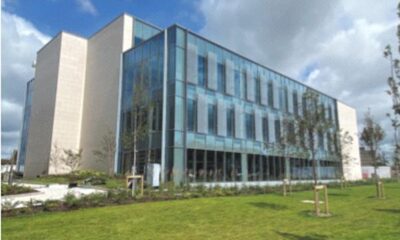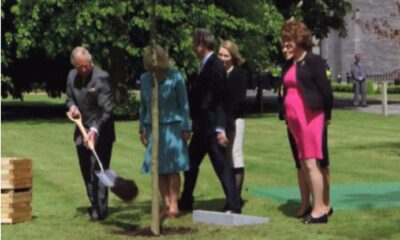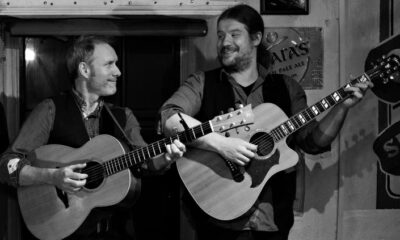CITY TRIBUNE
Claddagh Hooker dream becoming a reality as fleet gets ready for 2020

The red sails and black hulls of the iconic Galway Hooker have seen a resurgence in recent years – with a group of local volunteers working tirelessly to ensure that the long tradition of making and sailing the vessels is not lost.
Back in 2010, Báidoirí an Cladaig – the Claddagh Boatmen – commissioned local artist, Mike Devlin, to produce an image that reflected their dream – to once again have the renowned Claddagh Boats lining the wall of the Spanish Arch.
That dream became a reality on Culture Night last September when six of the vessels made their long awaited return to the Claddagh.

Reflecting the dream: the sketch by local artist Colm Devlin.
While the sight was spectacular and representative of centuries of tradition, Secretary of the Claddagh Boatmen, Peter Connolly, explains that it wasn’t all plain sailing.
It started back in 2008 when the group was revived and a collective of dedicated locals, with sailing in their blood, took on the restoration of their first hooker – Croí an Cladaig.
Fast forward just nine years and the group will this year have 14 of the famous boats displayed in the Claddagh Basin for their annual regatta in May – all as part of their aim to bring the boats front and centre for Galway’s year as European Capital of Culture in 2020.
Peter says that the need for the group came about when the tradition was threatened by an ever decreasing stock of the boats – mainly due to the costs involved in maintaining them.
“It was always a struggle – the boats are expensive and the average cost to do basic maintenance is probably €1,500 to €2,000 a year.
“That becomes prohibitive when you are doing it year after year,” says Peter.
The group specialises in acquiring the boats for restoration and rebuilding – this is something he says can be quite a contentious issue when it comes to securing the Boatmen’s position as a “bona fide heritage group”.
“The struggle is if a new boat is authentic or not – if it’s a piece of heritage and we believe it is.
“James Harrold [City Arts Officer] likened them to moving sculptures and living pieces of heritage and that’s what they are.
“We are dealing with a tradition – the boat builder in our case is an artist, it’s his pair of eyes and all we can do is aid and abet what he is doing, his shape and his design – he is the creator,” says Peter.
For Peter, the project is all about keeping tradition alive – something he sees as more than just creating museum pieces.
The important thing for the group is that these boats are in working condition and available for the people of Galway, and further afield, to sail on.
“If such a symbol of Galway can be rebuilt and showcased and we can get our young people to sail it, it’s either that or go look at a boat hanging from the ceiling in a museum.
“We don’t want that – it’s in our blood. We need to sail the boats, we need to get people sailing them and we need to get visitors sailing the boats,” exclaims Peter.
Peter believes that their structure as a group puts them in a better position to provide this exposure to sailing.
“It’s different when an individual owns a boat because you are always aware that insurance and pubic liability is a factor and taking people out can be problematic.
“With a community group and having bloc insurance and obviously being extremely careful, it is much easier to take out a visitor and expose people.
“What we have done for the last three years, we have targeted community groups and individuals and get as many people out in the bay as possible,” Peter says.
One of the key factors in this project has been the hard work and dedication of people on Community Employment schemes getting involved.
According to Peter, the Department of Social Protection can see the value in working alongside skilled trades people – especially when it comes to seeking long-term employment.
“The Department of Social Protection have to be applauded because they have constantly said that the access to solid work experience has been terrific.
“The Civic Trust Community Employment Scheme has, I think, over 80 per cent of people returning to work from people who go on work experience – that’s unbelievable and that’s the highest figure in the country at the moment,” says Peter.
As Peter outlines, the group hope that Community Employment Schemes will continue to supply workers for maintenance programmes for many years to come – with a stern commitment from the group that they will ensure those involved will leave with a range of new skills.
“The up-skilling alone on that is invaluable in terms of being employed in the future with any company.
“If you have someone that’s cross-trained – they can handle a boat, they can maintain an engine, they know the tides, that’s the versatility you need,” he says.
Plans for the Baídoirí and Cladaig’s fourth annual regatta are in full swing with a festival atmosphere set to envelop the Claddagh on May 27 and 28 – and the group has joined forces with boat owners across the county to bring their total tally up to 14.
“We are going to have 14 Claddagh boats displayed in the Claddagh Basin and each one will represent the 14 tribes.
“We have also just got word that the Viking Project in Northern Ireland, a community group that started building the Viking Boats, are going to bring down two boats for the event and display them in the Claddagh Basin as well,” says Peter.
Works on the Claddagh Basin that started in recent weeks will include an upgrade lock-gates – something Peter believes this creates a new opportunity for the berthing of the boats at the centre of the Claddagh – on full display for residents.
He feels this will be a great opportunity for locals to take ownership of the boats and see them at the heart of the community.
Peter said that the entire city has thrown its support behind the Boatmen with the business community providing backing for their festivals each year.
“The Latin Quarter has been very supportive for the last five years to bring the regatta to life in Galway City.
“The Salthill business group have come behind it totally this year as has the West End group of businesses and with that type of input and that kind of support – it keeps you going,” says Peter.
He credited City Council with praise for funding the project to the tune of about €10,000 per year for the past five years – a figure that the group matches through fundraising.
The Boatmen hope to be able to become self-sufficient and while it’s something Peter concedes won’t happen overnight – they do hope that their reliance on Council funding will reduce with a second licensed boat on the horizon and a licence just granted to hold a regular club lotto.
“We are hoping that we become self-financing with the licence and the lotto where we won’t constantly need the reliance on City Council.
“We want to break the reliance on going back to the Council for aid when other groups are starved for funds,” explains Peter.
Be sure to mark your diaries for the week of May 21 as the russet sails, instantly recognisable as quintessentially Galway, will once more fill the Claddagh Basin with colour.
CITY TRIBUNE
Galway ‘masterplan’ needed to tackle housing and transport crises
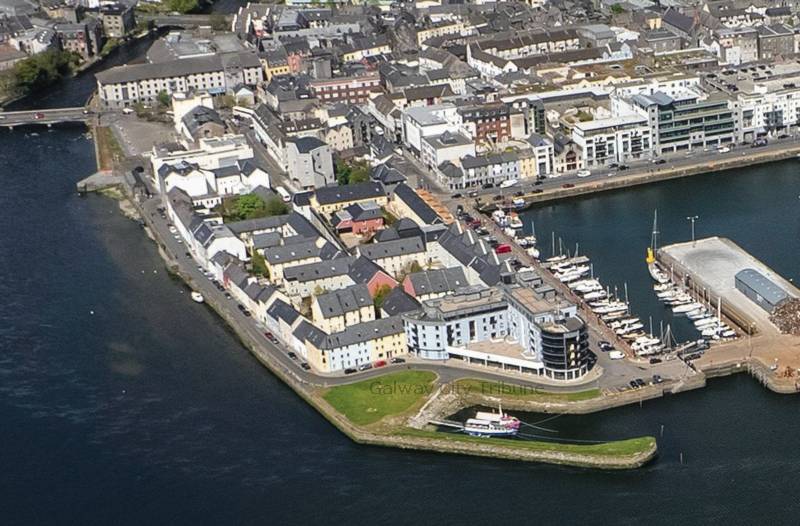
From the Galway City Tribune – An impassioned plea for a ‘masterplan’ that would guide Galway City into the future has been made in the Dáil. Galway West TD Catherine Connolly stated this week that there needed to be an all-inclusive approach with “vision and leadership” in order to build a sustainable city.
Deputy Connolly spoke at length at the crisis surrounding traffic and housing in Galway city and said that not all of the blame could be laid at the door of the local authority.
She said that her preference would be the provision of light rail as the main form of public transport, but that this would have to be driven by the government.
“I sat on the local council for 17 years and despaired at all of the solutions going down one road, metaphorically and literally. In 2005 we put Park & Ride into the development plan, but that has not been rolled out. A 2016 transport strategy was outdated at the time and still has not been updated.
“Due to the housing crisis in the city, a task force was set up in 2019. Not a single report or analysis has been published on the cause of the crisis,” added Deputy Connolly.
She then referred to a report from the Land Development Agency (LDA) that identified lands suitable for the provision of housing. But she said that two-thirds of these had significant problems and a large portion was in Merlin Park University Hospital which, she said, would never have housing built on it.
In response, Minister Simon Harris spoke of the continuing job investment in the city and also in higher education, which is his portfolio.
But turning his attention to traffic congestion, he accepted that there were “real issues” when it came to transport, mobility and accessibility around Galway.
“We share the view that we need a Park & Ride facility and I understand there are also Bus Connects plans.
“I also suggest that the City Council reflect on her comments. I am proud to be in a Government that is providing unparalleled levels of investment to local authorities and unparalleled opportunities for local authorities to draw down,” he said.
Then Minister Harris referred to the controversial Galway City Outer Ring Road which he said was “struck down by An Bord Pleanála”, despite a lot of energy having been put into that project.
However, Deputy Connolly picked up on this and pointed out that An Bord Pleanála did not say ‘No’ to the ring road.
“The High Court said ‘No’ to the ring road because An Bord Pleanála acknowledged it failed utterly to consider climate change and our climate change obligations.
“That tells us something about An Bord Pleanála and the management that submitted such a plan.”
In the end, Minister Harris agreed that there needed to be a masterplan for Galway City.
“I suggest it is for the local authority to come up with a vision and then work with the Government to try to fund and implement that.”
CITY TRIBUNE
Official opening of Galway’s new pedestrian and cycle bridge
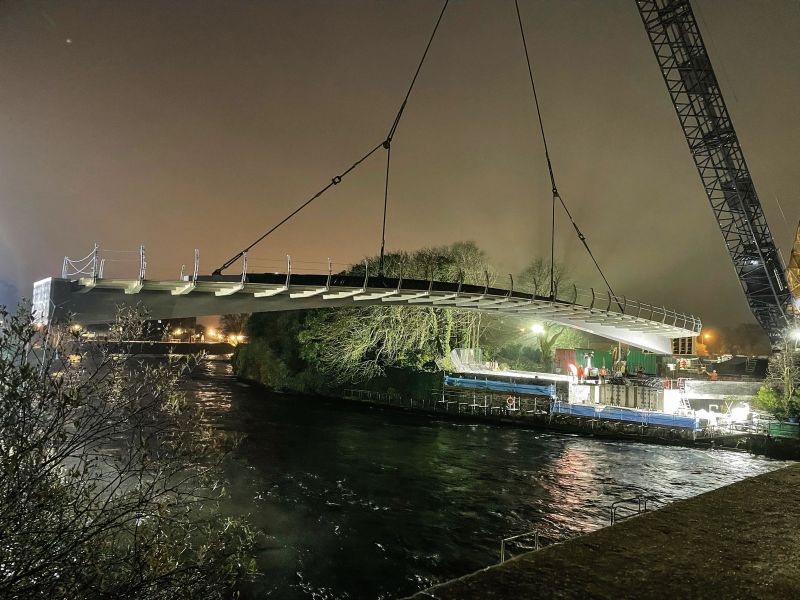
The new Salmon Weir pedestrian and cycle bridge will be officially opened to the public next Friday, May 26.
Work on the €10 million bridge got underway in April 2022, before the main structure was hoisted into place in early December.
A lunchtime tape-cutting ceremony will take place on Friday, as the first pedestrians and cyclists traverse the as-yet-unnamed bridge.
The Chief Executive of Galway City Council, Brendan McGrath, previously said the bridge, once opened, would remove existing conflicts between pedestrians, cyclists and traffic “as well as facilitating the Cross-City Link public transport corridor over the existing 200-year-old bridge”.
The naming of the new bridge has been under discussion by the Council’s Civic Commemorations Committee since late last year.
One name that has been in the mix for some time is that of the first woman in Europe to graduate with an engineering degree – Alice Perry.
Ms Perry, who was from Wellpark, graduated from Queen’s College Galway (now University of Galway) in 1906. The university’s engineering building is named in her honour.
The bridge was built by Jons Civil Engineering firm in County Meath and was assembled off-site before being transported to Galway. Funding for the project was provided in full by the National Transport Authority and the European Regional Development Fund.
(Photo: Sheila Gallagher captured the city’s new pedestrian footbridge being raised on the south side of the Salmon Weir Bridge in December. It will officially open next Friday, May 26).
CITY TRIBUNE
Minister branded ‘a disgrace’ for reversing land rezoning in Galway City

From the Galway City Tribune – Minister of State for Local Government and Planning, Kieran O’Donnell was labelled a “disgrace” for overturning councillors’ decisions to rezone land in the new City Development Plan.
Minister O’Donnell (pictured) confirmed in a letter to Council Chief Executive Brendan McGrath last week that he was reversing 25 material alternations made by councillors to the CDP 2023-29. He made the decision on the advice of Office of Planning Regulator (OPR).
Minister O’Donnell directed that 14 land parcels that were subject to land-use zoning changes by councillors as part of the Material Alterations to the Draft CDP should be reversed.
He directed that a further 11 land parcels in the city should become “unzoned”.
The Minister found that the CDP had not been made in a manner consistent with recommendations of the OPR, which required specific changes to the plan to ensure consistency with the national planning laws and guidelines.
At last week’s Council meeting Cllr Eddie Hoare (FG) asked for clarity on the process by which councillors could rezone the lands that had been changed by the Minister’s direction.
Cllr Declan McDonnell said, “What he [Minister O’Donnell] has done is an absolute disgrace”.
And he asked: “Do we have to have another development plan meeting to deal with it?”
Both Cllrs Hoare and McDonnell wondered what would become of the lands that were rezoned or unzoned by the ministerial direction.
Mr McGrath said the Council had put forward an argument in favour of retaining the material alterations in the plan, but ultimately the Minister sided with OPR.
He said if councillors want to make alterations to the new plan, they could go through the process of making a material alteration but this was lengthy.
The Save Roscam Peninsula campaign welcomed the Minister’s decision.
In a statement to the Galway City Tribune, it said the direction would mean the Roscam village area on the Roscam Peninsula will be unzoned and a number of land parcels would revert back to agriculture/high amenity.
A spokesperson for the campaign said: “the material alterations made by city councillors following lobbying by developers continued the long-standing practice of councillors facilitating a developer-led plan rather than an evidence- and policy-based plan that meets the needs of the city.
“The Minister’s direction is an important step in restoring confidence in the planning system. It is clear from the City Council’s own evidence on future housing projections that there was no requirement to zone these lands for residential purposes in order to meet the needs of the targeted population increase up to 2029,” the spokesperson added.


